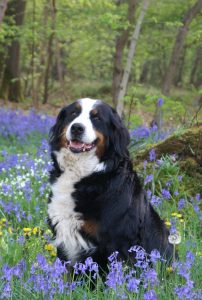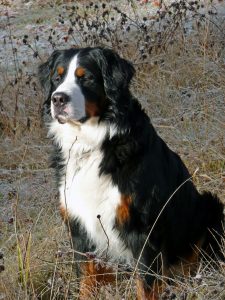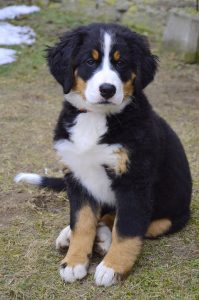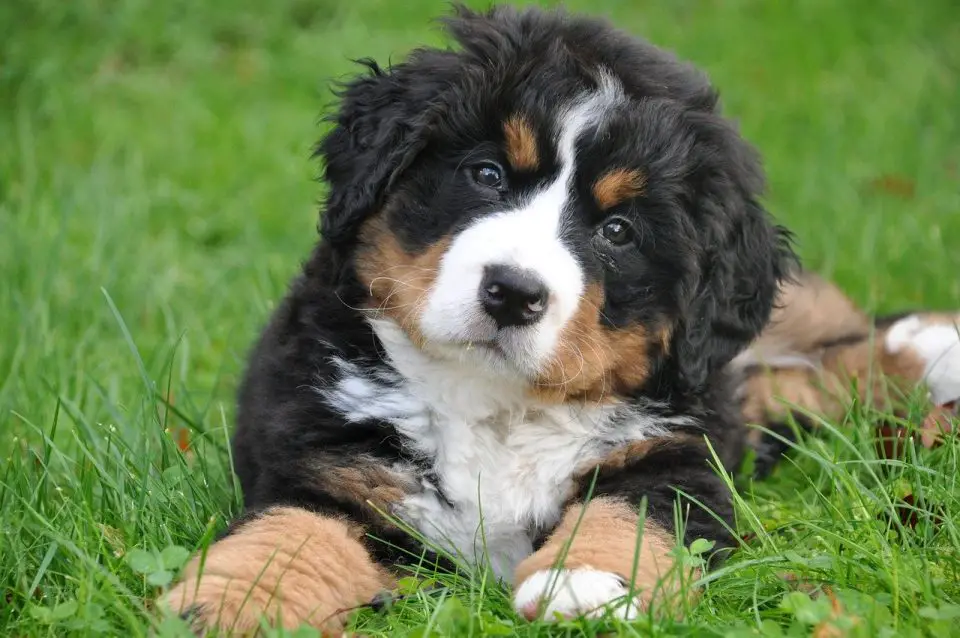Have you ever wanted a dog that looks a little more like a big shaggy bear? Same.
The Bernese Mountain Dog is a large, fluffy dog that happens to be one of my absolute favorite breeds.
Their adorable faces, thick, poofy fur and incredibly smart personalities basically makes them my dream dog.
Hi dog moms and dads! My name is Bri, and I already have my dream dog!
No, he’s not a Bernese Mountain Dog. Bruce is a mix of an American Bulldog and Pitbull Terrier and he’s 90 pounds of pure sweetness.
Clearly, I am a fan of big dogs! While I have never owned a Bernese Mountain Dog, it is definitely one of the breeds at the top of my bucket list.
However, part of how I decide what dog breed I want to own is knowing how much they shed. I have pretty bad allergies to dogs.
Even though Bruce sheds like crazy, I have been able to manage his shedding. I still have to be careful when I am bringing home a new dog so I know what to do to keep my allergy symptoms at bay.
If and when I decide to bring home a Bernese Mountain Dog, I will definitely need to get into a routine of maintaining the fur. These dogs SHED.
That being said, I put this shedding guide together not only for my own benefit, but to help other dog parents learn more about the breed. I will cover all the basics of shedding.
I will talk about the history of the breed, their coat, their shedding and tips and tools to manage their shedding. So without further ado, let’s get started.
History of the Bernese Mountain Dog
Bernese Mountain Dogs originate from the mountains of Bern, Switzerland. Makes sense, right?
These dogs were, and still are, absolute power houses. In the Bern mountains, these dogs were an essential member of farming families.
They were trained and trusted to herd and protect herds and livestock, but even more impressively, they could pull mass amounts of weight in farm equipment and goods. In fact, they can pull many times their own body weight.
These dogs have been around since long before machine farming equipment existed, and farmers relied on their strength to operate their tools.
Their size also made them great for scaring off predators and thieves.
The Bernese Mountain Dog continued to be a favored farm dog and companion until a farmer from the United States discovered the breed in the 1920’s.
Once they were in the states, the breed skyrocketed to the top of American farming dog lists.
They were recognized officially by the American Kennel Club in 1937 and to this day they are popular working dogs, but are also becoming more and more popular as plain old family companions.
What is a Bernese Mountain Dog’s Coat Like?

Remember the reference I made earlier to a fluffy bear? I was not kidding.
Part of why I love this breed so much is because of their thick, fluffy long coats.
They are mainly black in color, but are famous for their distinct white bellies, chest, paws and snouts with a white line reaching right up between their eyes to their forehead.
They also have some tan markings around their mouth and legs as well as incredibly adorable tan eyebrows. Yes you read that right, they have colored eyebrows.
These pups have a thick, double coat. The undercoat is wooly and dense and the outer coat is long and sleek.
Their long outer coats are soft and fluffy!
Do Bernese Mountain Dogs Shed? How Much?
| Yikes. Yes Bernese Mountain Dogs do shed. They shed very frequently. If you can’t handle the shedding, this is definitely not the dog for you.
The American Kennel Club has a helpful scale that shows how much dogs shed, which can be frequent, infrequent and anywhere in between. Unfortunately for those with allergies, Bernese Mountain Dogs tip the shedding scale all the way to frequent. Honestly, they could probably be put in their own category of extreme shedding breeds. Bernese Mountain Dogs shed like crazy, and it does not stop no matter what the season is. However, if it is even possible to do so, they do shed a bit more during specific times of the year. |
Let’s get into more details there in the next section!
When do Bernese Mountain Dogs Shed the Most?
Like I said earlier, Bernese Mountain Dogs shed regularly throughout the year. However, they do shed more during certain times.
There are several factors that might increase shedding in a Bernese Mountain Dog. Let’s take a look at the most common.
Stage of Life
There is nothing cuter than a Bernese Mountain Dog puppy. Except maybe Bruce, but I guess I am biased.
The great thing about young puppies is they shed much less than adults do. However, do not let that fool you!
Once puppies start to get a little older, they will start losing their puppy fur. During that transition, they will shed like nothing you have ever seen.
Especially Bernese Mountain Dogs! Don’t worry though, when they reach adulthood they will start shedding more regularly.
Not less, just more regularly.
Shedding Season
This is the big one! Shedding season happens twice a year and is essential to dogs regulating their body temperature throughout the year.
These seasons hit during the change of the seasons from winter to summer and again from summer to winter.
During this time, Bernese Mountain Dogs are shedding their coats to make room for the next one to grow in.
During the transition from winter to summer, Bernese Mountain Dogs no longer need their super thick, warm undercoats.
They will shed that dense fur to make room for a lighter, breezier coat that keeps them cool through the warm summer months.
Then, when winter starts coming back, they will shed that thin coat again and their thick one will grow back! During these two seasons you will see a dramatic increase in their shedding.
However, this is natural and necessary and there are ways to help manage it, which we will talk about later!
Diet and Exercise
Health starts from the inside out in all dogs. The proper diet and exercise is also important in all dogs, but can almost be argued as more important for breeds like the Bernese Mountain Dog.
A dog like this is bred for an active, hard working lifestyle. They need the right nutrition to keep up with their bodies’ needs.
Without those nutrients, their skin and coats could show signs of imbalance. Their fur could start to turn course, brittle and even start to fall out more than it is supposed to.
The same goes for exercise. Dogs who are over or underweight can also show symptoms of unhealthy skin and fur.
Make sure you talk to your vet and get your Bernese Mountain Dog on the right diet and exercise routine!
Pests and Skin Conditions
Many pests and bugs can cause skin irritations that make dogs lose more fur than normal. Fleas and ticks are the most common, which often cause excess licking and scratching.
Other pests like biting flies and mites can cause irritation and even carry diseases like mange, which can cause abnormal hair loss.
These pests can cause a number of other skin conditions, some of which can be dangerous and contagious.
If you notice your dog scratching or licking a certain area and they are also shedding more than normal, make sure you look for signs of pests and bugs!
How to Combat Bernese Mountain Dog Shedding
 Bernese Mountain Dogs have to shed to remain healthy. I always like to remind dog owners not to try to reduce shedding in their dogs, as this could lead to skin issues down the road.
Bernese Mountain Dogs have to shed to remain healthy. I always like to remind dog owners not to try to reduce shedding in their dogs, as this could lead to skin issues down the road.
However, there are definitely ways to manage their shedding to keep you from drowning in dog hair!
In fact, there are two things that I had to really get used to when I brought Bruce home and saw how bad he was shedding.
The first is getting into a good grooming routine. Bruce only needs brushed every other week or so because he is a short-haired dog.
However, every other month I take him to a professional groomer! With Bernese Mountain Dogs, these brushings and visits to the groomer may be more frequent.
These shaggy dogs need brushed out at least once a week, and during shedding season, probably once a day.
Professional grooming can be done at your preference, but I have found it makes a huge difference to take Bruce in now and then.
A professional groomer is just the deluxe version of what your dog would get at home, but it might help keep their shedding at bay even longer than an at-home brushing. Bathing helps too!
Bernese Mountain Dogs do not need frequent baths, but due to their long fur and active personalities, they are likely to get dirty now and then.
Giving them the occasional bath can help to loosen their dead fur.
If and when you give them a bath, make sure they are completely dry before you brush them out. Wet dog hair, especially long hair, can get tangled and pull.
This can be really painful for your pup! The other routine I have had to get into is regular cleaning around the house.
I know that seems silly, but I never thought I would use my vacuum cleaner so much until a dog was added to the mix. I vacuum at least once a week if not more.
The more you get into a routine of cleaning your home, the less you will notice pet hair!
Equipment to Help Combat Bernese Mountain Dog Shedding
Every dog parent needs the right tools at home to help them maintain their dog’s shedding.
Going back to my two points discussed in the last section, the best tools you can have in your arsenal are a great brush and a great vacuum cleaner.
When it comes to brushing a Bernese Mountain Dog, you need a brush that is specifically made for long-haired dogs. You also need to consider the dog’s undercoat.
You want a brush that will reach that undercoat and collect the loose fur without pulling fur that is still attached. There are many different brushes out there, but the Furminator line is my absolute favorite!
Furminator has multiple different brushes for different sized dogs, as well as different fur lengths. Make sure you get the one specifically for long-haired dogs for your Bernese Mountain Dog!
The other tool I could not live without is my Dyson pet hair vacuum cleaner. Yes – it was specifically made for collecting pet hair!
It is cordless which makes it way easier to carry around the whole house. Plus, it has several different attachments that I can use in tight corners and even on my furniture.
Are Bernese Mountain Dogs Considered to be Hypoallergenic?
For a dog to be considered hypoallergenic, it would need to not shed anything that could trigger a person’s allergies.
If you remember what I said at the beginning of this guide, the Bernese Mountain Dog definitely does not fit that description.
Even if they did not shed, all dogs shed skin cells, or dander. Pet dander is extremely rough on many people’s allergies!
Final Thoughts: Do Bernese Mountain Dogs Shed
 I have always been a fan of big dogs. When it comes to Bernese Mountain Dogs, their personality, size and cute faces make them one of my favorite breeds.
I have always been a fan of big dogs. When it comes to Bernese Mountain Dogs, their personality, size and cute faces make them one of my favorite breeds.
I personally have not pursued bringing home one of these dogs because I know their shedding would be too much for my allergies.
While that really sucks to admit, it is crucial that pet owners research these topics to make sure they can provide a permanent home for a dog they bring home.
However, if you have a good hold on your allergies and are ready to keep up with the maintenance required when you have a Bernese Mountain Dog, go for it!
They make incredible pets and will be a loyal, friendly companion for years.
Hope this helps! Happy pup parenting!
